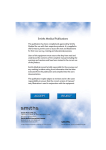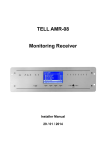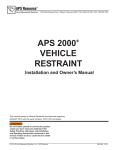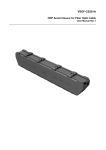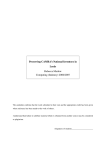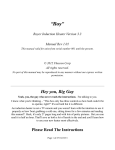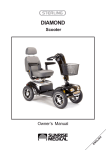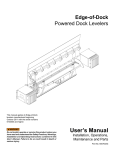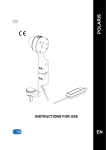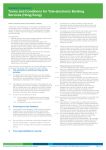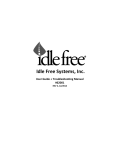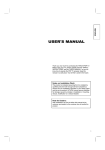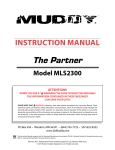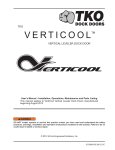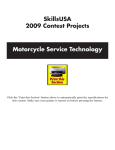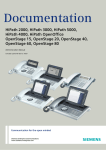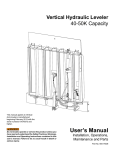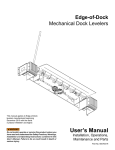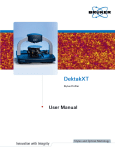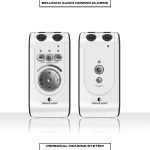Download User`s Manual - Curlin, Inc.
Transcript
Rail Lift Surface-Mounted Lift This manual applies to Rail Lifts manufactured beginning September 2013 with the serial numbers 61089635 and higher. Do not install, operate or service this product unless you have read and understand the Safety Practices, Warnings, Installation and Operating Instructions contained in this User’s Manual. Failure to do so could result in death or serious injury. User’s Manual Installation, Operations, Maintenance and Parts Part No. 6002750E table of contents Introduction..................................................................2 Safety Signal Words....................................................2 Safety Practices..........................................................3 Owner’s Responsibilities.............................................4 Installation...................................................................5 Operations...................................................................6 Rail Lift Options...........................................................7 Maintenance Device Operation................................... 8 Troubleshooting.........................................................10 Planned Maintenance................................................12 Mast Guide Roller Bearing Removal and Replacement..... 15 Wiring Schematic......................................................17 Hydraulic Schematic..................................................21 Parts List...................................................................22 Limited Warranty.......................................................27 Distributor Information...............................................28 introduction Welcome and thank you for choosing this Rail Lift for your material handling applications. This User’s Manual contains information that you need to safely install and identify parts for the Rail Lift. Please read and follow this User’s manual when installing the Rail Lift. safety signal words You may find safety signal words such as DANGER, WARNING, CAUTION or NOTICE throughout this User’s Manual. Their use is explained below: This is the safety alert symbol. It is used to alert you to potential personal injury hazards. Obey all safety messages that follow this symbol to avoid possible death or injury. Indicates an imminently hazardous situation which, if not avoided, will result in death or serious injury. Indicates a potentially hazardous situation which, if not avoided may result in minor or moderate injury. Indicates a potentially hazardous situation which, if not avoided, could result in death or serious injury. Notice is used to address practices not related to personal injury. 2 ©2013 4Front Engineered Solutions, Inc. 6002750E — Rail Lift Manual September 2013 safety practices INSTALLATION, MAINTENANCE AND SERVICE Read these safety practices before installing, operating or servicing the Rail Lift. Failure to follow these safety practices could result in death or serious injury. READ AND FOLLOW THE OPERATING INSTRUCTIONS CONTAINED IN THIS MANUAL BEFORE OPERATING THE Rail Lift. If you do not understand the instructions, ask your supervisor to teach you how to use the Rail Lift. OPERATION Use restricted to trained operators. Do not operate the Rail Lift while under the influence of drugs or alcohol. Do not stand in the driveway between the Rail Lift and a backing truck. Be certain that the truck wheels are chocked, or that the truck is locked in place by a truck restraining device before loading or unloading. Do not use the Rail Lift if it appears to be broken or does not seem to work properly. Inform your supervisor at once. Be certain, before doing any maintenance or repair under the Rail Lift that 1) the maintenance devices are securely in position and 2) the power is disconnected and properly tagged or locked off. All electrical trouble shooting or repair must be done by a qualified technician and must meet applicable codes. If it is necessary to trouble shoot inside the control box with the power on, USE EXTREME CAUTION. Do not place fingers or uninsulated tools inside the control box. Touching wires or other parts inside the control box may cause electrical shock, serious injury or death. Place barricades on the dock floor around the rail lift and in the driveway in front of the rail lift while installing, maintaining or repairing the rail lift. If you have any questions, contact your supervisor or your local 4Front Engineered Solutions, Inc. distributor for assistance. Stand clear of moving rail lift. Keep hands and feet clear of hinges at all times. Only authorized personnel should perform inspection or maintenance and service procedures. Unauthorized personnel attempting maintenance procedures do so at the risk of personal injury or death. Do not operate the Rail Lift with equipment, material or people on the lip. Always contact the factory for assistance whenever it is perceived that normal maintenance procedures cannot be followed. Do not attempt to manually lift the Rail Lift. Failure to properly adhere to maintenance device operation procedures is to risk the sudden and uncontrolled descent of the lift during maintenance or inspection. A falling lift can cause severe injury or death. Follow the procedures maintenance device operation instructions EVERY time you plan to reach or enter bodily beneath the lift to perform service or maintenance – no matter how momentary that might be. Ensure that there no obstructions which may interfere with the operation of the Rail Lift. If the Rail Lift does not operate correctly using the operating procedures contained in this manual, DO NOT USE THE Rail Lift. Call your local 4Front Engineered Solutions, Inc. distributor for service. Be certain no equipment, material or people are on or near the Rail Lift lip before allowing the truck to pull out. Do not operate the Rail Lift when anyone is underneath it unless they are securing a safety stand. Stand clear of moving rail lift. September 2013 If the maintenance device(s) are damaged or missing, stop immediately and contact the factory for assistance. The manufacturer can not foresee, and are not liable for, failure to use the approved maintenance device(s) and procedures that have been provided. Never go under an unsupported platform! To avoid personal injury or death, always be sure the load has been removed from the platform and that it has been blocked adequately to prevent shifting or dropping unexpectedly! 6002750E — Rail Lift Manual ©2013 4Front Engineered Solutions, Inc. 3 safety practices, continued If NOT operational: The carriage MUST be blocked adequately from beneath until the time that the lift is made operational again. If the rail lift cannot be lowered normally, contact the factory for assistance. If stuck or stalled, the carriage should be secured at its stuck position before attempting to walk on or under the platform. All loads must be removed from the Rail Lift platform prior to engaging the maintenance devices. These devices are designed to support an unloaded platform only. Failure to remove the load from the platform prior to blocking could cause the failure of the maintenance devices and allow the lift to fall unexpectedly. Do not stand under the platform while setting the maintenance devices into position. Check the stability of the supports. Make sure there is no debris under the lower end of the maintenance devices. No maintenance, or lubrication, shall be performed when the Rail Lift is in operation. All Safety devices or guards, handrails shall be in place before starting equipment for normal operation. oWNER’S RESPONSIBILITIES It is the responsibility of the user/purchaser to advise the manufacturer where deflection may be critical to the application. Inspection and Maintenance The lift shall be inspected and maintained in proper working order in accordance with the manufacturer’s operating/ maintenance manual and safe operating practices. Only trained personnel and authorized personnel shall be permitted to perform maintenance/service operations on the lift. Before Operation Before using the lift, the operator shall have: • Read and/or have explained, and understood, the manufacturer’s operating instructions and safety rules. • Inspected the lift for proper operation and condition. Any suspect item shall be carefully examined and a determination made by a qualified person as to whether it constitutes a hazard. All items not in conformance with the manufacturer’s specification shall be corrected before further use of the lift. Maintenance/Service personnel shall have: • Read and/or have explained and understood, the manufacturer’s operating/maintenance manual, and all safety rules and labels, prior to performing any maintenance/ service operations on the equipment. During Operation The lift shall only be used in accordance with the manufacturer’s operating/maintenance manual. • Full time unlimited access to the manufacturer’s operating/ maintenance manual. • Ensure that all safety devices are operational and in place. Removal from Service Any lift not in safe operating condition such as, but not limited to excessive leakage, missing rollers, pins or fasteners, any bent or cracked structural members, cut or frayed electric, hydraulic or air lines, damaged or malfunctioning controls or safety devices, etc. shall be removed from service until it is repaired to the original manufacturer’s standards. All repairs shall be made by qualified personnel in conformance with the manufacturer’s instructions. Modifications or Alterations Modifications or alternations of industrial scissors lifts shall be made only with written permission of the original manufacturer. These changes shall be in conformance with all applicable provisions of this standard and shall be as safe as the equipment was before modification. These changes shall also satisfy all safety recommendations of the original equipment manufacturer for the particular application of the lift. • Do not overload the lift. Operators Only trained personnel and authorized personnel shall be permitted to operate the lift. 4 ©2013 4Front Engineered Solutions, Inc. 6002750E — Rail Lift Manual September 2013 installation Fig. 1 To avoid bodily injury read and follow all instructions before installing, operating or servicing the rail lift. Before installation, read and follow the Safety Practices on page 3. Failure to follow these safety practices could result in death or serious injury. READ AND FOLLOW THE OPERATION INSTRUCTIONS IN THIS MANUAL BEFORE OPERATING THE RAIL LIFT. If you do not understand the instructions, ask your supervisor to teach you how to use the rail lift. NOTE: For Rail Lifts requiring higher than standard travel range, the deck and A-Frame assemblies may ship unattached to the main assembly. For these orders, see supplemental installation sheet for installation details. 1. Upon receipt of rail lift examine all packages for shipping damages and make claims against carrier for damages. A-Frame assembly Deck assembly Front anchor angle Mast rail assembly Floor mounted approach ramp Power unit cover Rear anchor angles 2. Check that floor is flat and level. 3. For units with remote control panel and/or power pack, install hoses and control wire through conduit in floor. 4. Connect hoses to rail lift cylinder (if applicable). 5. Using a fork lift or crane place the rail lift into the desired position. Check for any interference with the deck and the A-frame. 6. If the rail lift does not have an internal power pack, install power pack as per wiring and hydraulic schematics. Check for proper motor rotation to avoid pump damage. Check if all fitting connections are tight. Anchor the power pack to the floor or mount it on the wall bracket. Do not install the rail lift anchor bolts into aged or unsound concrete. 7. The rail lift must be mounted to a concrete pad using six (6) 5/8" diameter x 4.5" minimum long expansion anchors. Follow the manufacturer’s recommended installation instructions for the anchors. 8. Bleed the hydraulic cylinder of air by slowly loosening the plug until air escapes. As soon as only oil is escaping, tighten the plug. September 2013 6002750E — Rail Lift Manual ©2013 4Front Engineered Solutions, Inc. 5 Operations Before operation, read and follow the Safety Practices on page 3. Failure to follow these safety practices could result in death or serious injury. READ AND FOLLOW THE OPERATION INSTRUCTIONS IN THIS MANUAL BEFORE OPERATING THE RAIL LIFT. If you do not understand the instructions, ask your supervisor to teach you how to use the rail lift. DESCRIPTION ● The push-button station is on a coil cord or can be fixed to the wall or to the guard rail ● Optional equipment for the controls are: in motion flashing light, in motion warning beeper, keyed on/off, Stop button, and a second push-button station OPERATION PROCEDURES GENERAL: ● Cantilever type design To avoid bodily injury read all instructions before operating or servicing rail lift. ● Side mounted, direct thrust cylinder LOADING/UNloading: ● Deck surface of the rail lift must always be level with the truck bed, building floor or any other surface that goods are to transferred to or from ● The deck assembly is guided by eight oversized ball bearing rollers riding on heavy duty elevator mast rail, providing excellent stability for full capacity loading from any of the three open sides DECK: ● Rigid deck consisting of a welded structural steel assembly with a non-skid checker plate surface ● Beveled toe guards around three sides of the perimeter HYDRAULICS: ● Direct thrust, extra heavy duty walled cylinder ● Velocity fuse that will lock and fully support the deck assembly (including the load at rated capacity) in the event of hose failure ● The cylinder is sealed by a polyetheleyne U-ring, an Hstyle double lip wiper and a high strength low friction wear ring provide superior rod cleaning and support ● The power pack assembly is comprised of a direct coupled motor and fully submerged pump, oil reservoir, suction strainer, solenoid operated lowering valve, pressure relief valve and a pressure compensated flow control valve. CONTROLS: ● The control panel is comprised of a NEMA 12 enclosure (NEMA 4 optional) with a magnetic contactor with thermal overload motor protection ● Control voltage is 24 VAC (other voltages are optional) is provided by a transformer in the control panel. ● Push-button station is NEMA 4 rated and consists of two constant pressure type buttons 6 ©2013 4Front Engineered Solutions, Inc. ● Extend the lip before entering the vehicle, retract the lip when complete. ● The lip is to enter a truck, no less than six inches ● Do not change direction (except in a forward or backward motion) while on the lip ● The rail lift will accept an unbalanced load, but every effort should be made to place the center of gravity of the load over the center of the deck OPERATION: Always have the handrails and the safety chains secured when moving the deck up or down. Stand clear of moving rail lift. ● To raise or lower the deck assembly, depress and hold the corresponding button until the deck is at the desired height, then release the button and the deck will stop ● When the “UP” button is depressed, the motor and pump start, pushing hydraulic oil from the reservoir through the lowering valve and into the cylinder ● Pushing the “DOWN” button actuates the solenoid operated lowering valve, allowing the hydraulic oil to return to the reservoir along the pressure line and by-pass the pump 6002750E — Rail Lift Manual September 2013 rail lift options TRAVEL OPTIONS ● Table travel is standard at 60 inches, other travel requirements can be met if ordered at time of manufacturing BOLT TO WALL MOUNTING ● If space restrictions prevent the standard gusset with rear anchor set up from being used, an alternative mounting may be ordered at the time of manufacture. The alternative is to bolt the mast rail assembly to a suitable composite material wall. SAFETY MOTION ALERT ● This option warns personnel whenever the lift is moving by means of a warning beeper mounted in the control panel. A flashing warning light mounted in the control panel is also available. ALUMINUM LIP AND RAMP ● For situations where a large lip is required but the weight of a steel lip is too much for the personnel using the lift. An aluminum lip offers the same capabilities at one third to one half the weight of a similarly dimensioned steel ramp. CONTROL PANEL OPTIONS: ● Keyed on/off, in motion light, in motion warning beeper, Stop button, flanged fused disconnect, pre-wired panel mounted on a remote power pack September 2013 6002750E — Rail Lift Manual ©2013 4Front Engineered Solutions, Inc. 7 maintenance device operation Fig. 2 Only authorized personnel should perform inspection or maintenance and service procedures. Before servicing the rail lift, read and follow the Safety Practices on page 3, and the Operation instruction section on page 6 of this User's manual. Failure to do so could result in death or serious injury. STANDARD MAINTENANCE DEVICE (See fig. 2) TO ENGAGE 1. Raise platform above maintenance devices. 2. For both sides, pull the maintenance device out of the stored location. 3. Rotate the device and engage the pin within the hole of the mast rail. 4. Push the maintenance device completely though the mast rail. 5. Ensure both sides have the maintenance device fully engaged through the mast rail. 6. Lower platform until it comes to rest on the maintenance device. Once the platform is supported continue to hold the DOWN button for 5-10 seconds to relieve the hydraulic system of pressure. 7. Confirm that the platform is securely supported by both maintenance devices. 8. Disconnect and lock-out/tag out all electrical and/or other power sources to prevent an unplanned or unexpected actuation of the lift TO DISENGAGE 1. Raise platform above maintenance devices. 2. For both sides, pull the maintenance device out of the engaged position. 3. Rotate the device and store it within the hole located in the gusset. 4. Ensure both sides have the maintenance device disengaged and stored. 5. Continue operation of the unit. 8 ©2013 4Front Engineered Solutions, Inc. 6002750E — Rail Lift Manual September 2013 maintenance device operation, continued ALTERNATIVE MAINTENANCE DEVICE (See fig. 3) TO ENGAGE 1. Raise platform approximately 4 feet above ground level. Fig. 3 2. Remove the maintenance struts from their storage position and rotate them into a vertical position. See Fig 3. 3. Lower the lift to be supported by both maintenance struts. Once the platform is supported continue to hold the DOWN button for 5-10 seconds to relieve the hydraulic system of pressure. 4. Ensure the bottom of both maintenance struts are captured inside their support box assemblies. Maintenance strut 5. Disconnect and lock-out/tag out all electrical and/or other power sources to prevent an unplanned or unexpected actuation of the lift. Support box assembly TO DISENGAGE 1. Raise platform approximately 6 inches. TO DISENGAGE, continued 2. Store the maintenance struts by rotating them back to their storage position under the deck platform. 3. Continue operation of the unit. September 2013 6002750E — Rail Lift Manual ©2013 4Front Engineered Solutions, Inc. 9 troubleshooting Be certain, before doing any maintenance or repair under the Rail Lift that 1) the maintenance devices are securely in position and 2) the power is disconnected and properly tagged or locked off. Stand clear of moving rail lift. NOTE: This troubleshooting section assumes that the rail lift has been installed properly and that all electrical and hydraulic connections have been made correctly. If this is a new installation or electrical or hydraulic work has been done on the unit, refer to the appropriate schematics and/or instructions to verify that the unit is installed correctly. Before servicing the rail lift, read and follow the Safety Practices on page 3, and the Operation instruction section on page 6 of this User's manual. Failure to do so could result in death or serious injury. PROBLEM POSSIBLE CAUSE SOLUTION a) Installation connections are not made. a) Check to ensure all installation connections are made. b) Motor not wired properly. b)Ensure motor is wired properly. 2. Motor/Pump operate, but rail lift fails to raise. a)Pressure relief is set too low. a)Check to ensure pressure relief is opened up sufficiently to allow the table to raise under rated capacity. 3. Rail lift quickly creeps down while in a raised position. a) Hydraulic oil is leaking. a)Ensure that there are no visible hydraulic oil leaks anywhere in the system. b) Hydraulic oil is contaminated. b)Hydraulic oil must be flushed and replaced with new clean oil (use only the oils recommended in the Maintenance and Lubrication section on page 13 in this manual. c)Contaminated hydraulic oil is preventing check valave from closing properly. c)Remove and clean the check valve and make sure that the seat area in the valve is not damaged. If the seat is damaged, call your local 4Front distributor for the replacement valve. d)Contaminate hydraulic oil has damaged seals in valve manifold. d)Call your local 4Front distributor for replacement seal kits. 1. Rail lift fails to operate. 10 ©2013 4Front Engineered Solutions, Inc. 6002750E — Rail Lift Manual September 2013 troubleshooting, continued PROBLEM POSSIBLE CAUSE SOLUTION 4. Rail lift lowers too quickly. a) Improperly rated flow control. a) Replace the flow control with a smaller one (NOTE: for units with adjustable flow controls you only need to close valve sufficiently to provide the desirable down speed.) 5. Motor chatters and rail lift fails to raise. a)Contactor not pulling in. a)Push contactor in manually to confirm. 6. Rail lift fails to lower. a) Faulty solenoid. a)Check to ensure solenoid on hydraulic manifold to confirm. b) Adjustable flow control is completely closed. b)Ensure flow control is not closed completely. c) Hydraulic oil is leaking. c)Check for leaks in the hydraulic system. If leaks exist, velocity fuse on cylinders may have tripped. Fix leaks and repressurize hydraulic system, then lower. September 2013 6002750E — Rail Lift Manual ©2013 4Front Engineered Solutions, Inc. 11 planned maintenance Every 90 days inspect all safety labels and tags to ensure they are on the rail lift and are easily legible. If any are missing or require replacement, please call your local authorized 4Front Engineered Solutions, Inc. distributor. Fig. 4 6010489 (x2) (std.) 6010377 (x2) (alternative) or 3003147 (A/R) 6003148 (x2) 6008547 or 6008548 6007121 (1 per lift) 6003150 (1 per handrail) 12 ©2013 4Front Engineered Solutions, Inc. 6002750E — Rail Lift Manual September 2013 planned maintenance, continued Be certain, before doing any maintenance or repair under the Rail Lift that 1) the maintenance devices are securely in position and 2) the power is disconnected and properly tagged or locked off. Stand clear of moving rail lift. Before servicing the rail lift, read and follow the Safety Practices on page 3, and the Operation instruction section on page 6 of this User's manual. Failure to do so could result in death or serious injury. Use only lubricants referenced below. Improper lubrication or adjustments may cause operational problems. monthly annually 1. Clean motor/pump assembly. 1. Drain, flush and change oil. Use only Mobil Aero HFA (49011), Exxon Univis Grade J13, Texaco Aircraft Oil #1537BB or U.S. Oil Co., Inc. #5606 (low temp.) 2. Clear dust and debris. 3. Keep deck surface clean of all grease, oil and debris. 4.Ensure that all chains, handralis and safety features are in place and function properly. 2. Remove and clean hydraulic oil pump strainer and reservoir magnet. 3. Clean inside of reservoir of any debris from old oil. 4. Remove all grease and build-up from mast rail. Re-grease the mast rail after it is cleaned. quarterly 1. Grease the mast rail where the bearings make contact. use general purpose grease. 2. Check mast guide bearings for signs of damage. If any damage is apparent, replace bearing immediately. 3. Check hoses and fittings for cracks and leaks. 4. Clean accumulated dirt and grease from hoses so that cracks and leaks can be easily identified. 5.Inspect all safety labels and tags. Replace if necessary. See page 12 for safety label locations. 6. Check fluid level. Use only Mobil Aero HFA (49011), Exxon Univis Grade J13, Texaco Aircraft Oil #1537BB or U.S. Oil Co., Inc. #5606 (low temp.) September 2013 6002750E — Rail Lift Manual ©2013 4Front Engineered Solutions, Inc. 13 planned maintenance, continued Fig. 5 Legend Symbol Description Lubricate - oil Light oil - SAE 30 Lubricate - grease Molybdenum disulfide NLGI #2 Cleaning (Location - frequency) Visually inspect (Replace damaged or worn) Clean debris from under Rail Lift deck assembly 14 ©2013 4Front Engineered Solutions, Inc. 6002750E — Rail Lift Manual September 2013 Mast Guide Roller Bearing removal and replacement Cylinder Removal And Replacement Fig. 6 Be certain, before doing any maintenance or repair under the Rail Lift that 1) the maintenance devices are securely in position and 2) the power is disconnected and properly tagged or locked off. NOTE: Handrail not shown. Stand clear of moving rail lift. Lifting lug position on back plate (pre-cut) Before servicing the rail lift, read and follow the Safety Practices on page 3, and the Operation instruction section on page 6 of this User's manual. Failure to do so could result in death or serious injury. 1. Raise deck assembly to approximately two feet above grade and place supports under the deck assembly. Be sure that the supports can sufficiently support the weight of the deck. 2. If using a tow motor or lift truck to lift underneath the deck go to instruction 7. Lifting lug position on deck 3. Install load centering eye bolts in the holes provided in the vertical back plate of the deck assembly and the deck plate. See Fig. 6 for details. 4. Unbolt the ram of the cylinder from the A-frame assembly. Once the cylinder is free, clamp or tie the A-frame to the back of the deck assembly. 5. Disconnect all wires (if applicable) from the deck assembly. Only tables with options such as perimeter safety stops or upper travel limit switches should have wires attached to the deck assembly. 6. Clamp or strap the cylinder to the mast assembly. Ensure the cylinder will stay vertical once the deck assembly is removed. 7. With the load centering eye bolts in place on the deck assembly, vertically raise the deck assembly off the mast assembly. Place the deck assembly on a solid level surface to be worked. 8. With the deck assembly removed, now the cylinder can be removed or worked on. 9. Once the cylinder has been replaced, or the work is complete, ensure the cylinder is raised back to the vertical position and is ready to be bolted the A-Frame assembly. September 2013 6002750E — Rail Lift Manual ©2013 4Front Engineered Solutions, Inc. 15 Mast Guide Roller Bearing removal and replacement, continued The deck assembly has a weight imbalance which must be handled very cautiously when lifting the deck off of the mast rails. The majority of the weight is on the rail side of the deck. If using a lift truck or tow motor to remove the deck assembly it is strongly advised that the deck assembly be clamped to the forks of the lift truck. When using a crane to remove the deck assembly be sure to have an experienced rigger set up the chains or straps before attempting to lift the deck assembly clear of the rails. 10. Using split ring pliers remove the retaining rings from the mast guide bearings assemblies. With the retaining rings removed all the rollers on the deck assembly should come off with little effort. If a roller is seized on the stud, be sure not to damage the stud while removing the bearing. 11. Replace all the old rollers with new rollers and re-install the retaining rings. (Be sure that the new bearings are packed with grease.) If a roller bearing replacement kit was purchased there will be new retaining rings in it. 12. With EXTREME caution lift the deck assembly back onto the mast assembly. Be sure to use caution when getting the mast guide bearings started onto the mast assembly so as not to damage the mast guide bearings. 13. Reconnect all wires that were disconnected to facilitate deck assembly removal. Re-bolt the A-frame to the cylinder ram. 14. Remove the load centering eye bolts from the deck assembly. 15. Restore power to the rail lift and remove supports from underneath the deck assembly. 16 ©2013 4Front Engineered Solutions, Inc. 6002750E — Rail Lift Manual September 2013 wiring schematic Before doing any electrical work, make certain the power is disconnected and properly tagged or locked off. All electrical work must be done by a qualified technician and meet all applicable codes. If it is necessary to make troubleshooting checks inside the control box with the power on, USE EXTREME CAUTION. Do not place your fingers or uninsulated tools inside the control box. Touching wires or other parts inside the control box could result in electrical shock, death or serious injury. Fig. 7 September 2013 6002750E — Rail Lift Manual ©2013 4Front Engineered Solutions, Inc. 17 wiring schematic, continued Fig. 8 18 ©2013 4Front Engineered Solutions, Inc. 6002750E — Rail Lift Manual September 2013 wiring schematic, continued Fig. 9 September 2013 6002750E — Rail Lift Manual ©2013 4Front Engineered Solutions, Inc. 19 wiring schematic, continued Fig. 10 20 ©2013 4Front Engineered Solutions, Inc. 6002750E — Rail Lift Manual September 2013 hydraulic schematic Fig. 11 September 2013 6002750E — Rail Lift Manual ©2013 4Front Engineered Solutions, Inc. 21 parts list Alternative Maintenance Device To ensure proper function, durability and safety of the product, only replacement parts that do not interfere with the safe, normal operation of the product must be used. Incorporation of replacement parts or modifications that weaken the structural integrity of the product, or in a way alter the product from its normal working condition at the time of purchase could result in product malfunction, breakdown, premature wear, death or serious injury. 17 Fig. 12 6 18 19 5 3 16 4 2 1 7 8 15 14 9 20 13 10 12 11 22 ©2013 4Front Engineered Solutions, Inc. 6002750E — Rail Lift Manual September 2013 parts list, continued ItemQuantityPart DescriptionPart Number 1 1 Deck Assembly Consult Factory 2 1 Handrail Assembly Consult Factory 3 1 A-Frame Assembly, 60" Travel 6010024 4 1 Flat Washer, 3/8" 000-051 5 1 Lock Washer, 3/8" 234301 6 1 Socket Head Cap Screw, 3/8-16 x 1.5" Thread 213454 7 8 Mast Guide Bearing 6010056 8 4 External Retaining Ring, 1-3/8" ID 6010404 9 1 Lift Cylinder, 60" Travel 6010063 10 1 Hydraulic Power Unit, 5HP (208-230/460 VAC), 3 Phase (For other voltages consult factory) 380382 11 1 Mast Assembly Consult Factory 12 1 Pin, Lift Cylinder 6008327 13 1 Ramp Assembly Consult Factory 14 2 Maintenance Stop Assembly 6010252 15 1 Pin, A-Frame 6008328 16 2 Maintenance Strut 6010397 17 4 Clevis Pin, 1/2" Dia x 2-1/4" Long 231506 18 8 Plain Washer, 9/16" ID 234121 19 1 Cotter Pin, 1/8" x 3/4" 231341 20 1 Serial tag September 2013 6009761 6002750E — Rail Lift Manual ©2013 4Front Engineered Solutions, Inc. 23 parts list, continued Fig.13 9 8 10 1 7 2 6 3 5 4 ItemQuantityPart DescriptionPart Number 1 1 Filter Breather 033013 2 1 Sight Gauge 033028 3 1 Pressure Gauge, 0-4000 psi (Optional) 033022 4 1 Flow Control Valve 024015 5 1 Elbow, 1/2" M NPT TO #8 M JIC 026076 6 1 Pressure Relief Valve 024165 7 1 Solenoid Coil 024104 8 1 Valve Cartridge 024167 9 1 Velocity Fuse, 10 GPM 313239 10 1 1/2" Hydraulic Hose Assembly, 30" Long 6001899 24 ©2013 4Front Engineered Solutions, Inc. 6002750E — Rail Lift Manual September 2013 parts list, continued Fig. 14 18 19 20 21 22 2 4 5 6 7 8 9 10 11 12 13 14 25 24 15 16 23 1 26 3 17 September 2013 6002750E — Rail Lift Manual ©2013 4Front Engineered Solutions, Inc. 25 parts list, continued Where Used/Quantity Complete Control Panel 6010401V4 6010401V5 6010401V6 6010401V7 6010401V8 ItemPart DescriptionPart Number 1 Bar, Ground 2 Circuit protector, thermal, 1-pole, 2AMP 3 Sprial cable, 16-3C SJO, 48" retracted, 20' extended, 6" leads 4 Block, Fuse, 2 Pole, Class CC, BC series 5 Fuse, Time Delay 6 Block, Fuse, 2 Pole, Class CC, BC series 7 Fuse, Time Delay 8 Block, Fuse, 2 Pole, Class CC, BC series 9 Fuse, Time Delay 10 Block, Fuse, 2 Pole, Class CC, BC series 11 Fuse, Time Delay 12 Block, Fuse, 2 Pole, Class CC, BC series 13 Fuse, Time Delay 208V/3/60 240V/3/60 380V/3/50 480V/3/60 600V/3/60 1 6000559 1 1 1 1 6000495 1 1 1 1 1 4ZZ-1603-48-SJO 1 1 1 1 1 6000556 1 FNQ-R-6/10 2 6000556 1 FNQ-R-1/2 2 6000556 1 FNQ-R-3/10 2 6000556 1 FNQ-R1/4 2 6000556 1 FNQ-R1/4 2 14 IEC Contactor, Non-reversing, 24VAC, 3-Pole, +1NO+1NC, 1-15hp/18A 6000467 1 1 1 1 15 Overload Relay, 5.5-8 AMP 6000476 1 1 1 16 Overload Relay, 12-18 AMP 6000478 1 1 17 Pendant Station, 2 NO, 2 Pushbutton, Up/Down 9001BW72Y 1 1 1 1 1 18 XFMR, 208V to 24V, 50VA 9070T50D14 1 19 XFMR, 240/480V to 24V, 50VA 9070T500D2 20 XFMR, 360/380/400V to 24V, 50VA 9070T50D73 21 XFMR, 240/480V to 24V, 50VA 9070T500D2 22 XFMR, 600V to 24V, 50VA 9070T50D16 1 1 1 1 1 ItemQuantityPart DescriptionPart Number 23 1 Surge Supressor 6006852 24 2 End STOP, Screwless, 6mm 6000549 25 7 Terminal, 4 Pole 6006846 26 3 Terminal, 2 Pole 6007888 26 ©2013 4Front Engineered Solutions, Inc. 6002750E — Rail Lift Manual September 2013 limited warranty 4Front Engineered Solutions, Inc. expressly warrants that this RAIL LIFT will be free from flaws in material and workmanship under normal use for a period of one (1) year from the earlier of 1) 60 days after the date of initial shipment by 4Front Engineered Solutions, Inc., or 2) the date of installation of the RAIL LIFT by the original purchaser, provided the purchaser maintains and operates the RAIL LIFT in accordance with this User’s Manual. In the event the product proves deficient in material or workmanship, 4Front Engineered Solutions, Inc. will at its option: 1. Replace the product or the deficient portion thereof without charge to the purchaser; or 2. Alter or repair the product; on site or elsewhere, as 4Front Engineered Solutions, Inc. may deem advisable, without charge to the purchaser. This limited warranty stated in the preceding paragraph IS EXCLUSIVE AND IT IS IN LIEU OF ANY OTHER GUARANTEES AND WARRANTIES, EXPRESS OR IMPLIED. The limited warranty does not cover any failure caused by improper installation, misapplication, overloading, abuse, negligence, or failure to maintain and adjust the RAIL LIFT properly. Parts requiring replacement due to damage resulting from vehicle impact, abuse, or improper operation are not covered by this warranty. 4Front Engineered Solutions, Inc. disclaims any responsibility or liability for any loss or damage (including, without limitation, direct, indirect or consequential damages, or lost profits or production time) that results from the use of unauthorized replacement parts or modification of the RAIL LIFT. 4Front Engineered Solutions, Inc. sole obligation with regard to a RAIL LIFT that proves to be deficient in material or workmanship shall be as set forth in its standard limited warranty above (i.e., 4Front Engineered Solutions, Inc. will, at its option, repair or replace the RAIL LIFT or portion thereof, without charge to the purchaser.). This limited warranty does not cover any failure caused by improper installation, abuse, negligence, or failure to properly maintain and adjust the RAIL LIFT. This limited warranty will be void or of no effect if the original purchaser does not notify 4Front Engineered Solutions, Inc.’s warranty department within ninety (90) days after the product flaw is discovered. Parts requiring replacement due to damage resulting from vehicle impact, abuse, or improper operation are not covered by this warranty. 4Front Engineered Solutions, Inc. disclaims any responsibility or liability for any loss or damage that results from the use of unauthorized replacement parts or modification of the RAIL LIFT. THERE ARE NO WARRANTIES, EXPRESS OR IMPLIED, WHICH EXTEND BEYOND THE DESCRIPTION ON THE FACE HEREOF, AND THERE IS NO WARRANTY OF MERCHANTABILITY OR OF FITNESS FOR A PARTICULAR PURPOSE. 4Front Engineered Solutions, Inc. warranties extend only to the RAIL LIFT itself. 4Front Engineered Solutions, Inc. DISCLAIMS all warranties, express or implied, responsibility or liability for loss or damage of any kind associated with the installation or maintenance of the RAIL LIFT, including any liability for premature product wear, product failure, property damage or bodily injury arising from improper installation or maintenance of the RAIL LIFT. September 2013 6002750E — Rail Lift Manual ©2013 4Front Engineered Solutions, Inc. 27 Please direct questions about your Rail Lift to your local distributor or to 4Front Entrematic. Your local 4Front Engineered Solutions, Inc. distributor is: Corporate Head Office: 1612 Hutton Dr. Suite 140 Carrollton, TX. 75006 Tel. (972) 466-0707 Fax (972) 323-2661 ©2013 4Front Engineered Solutions, Inc. Part No. 6002750E




























